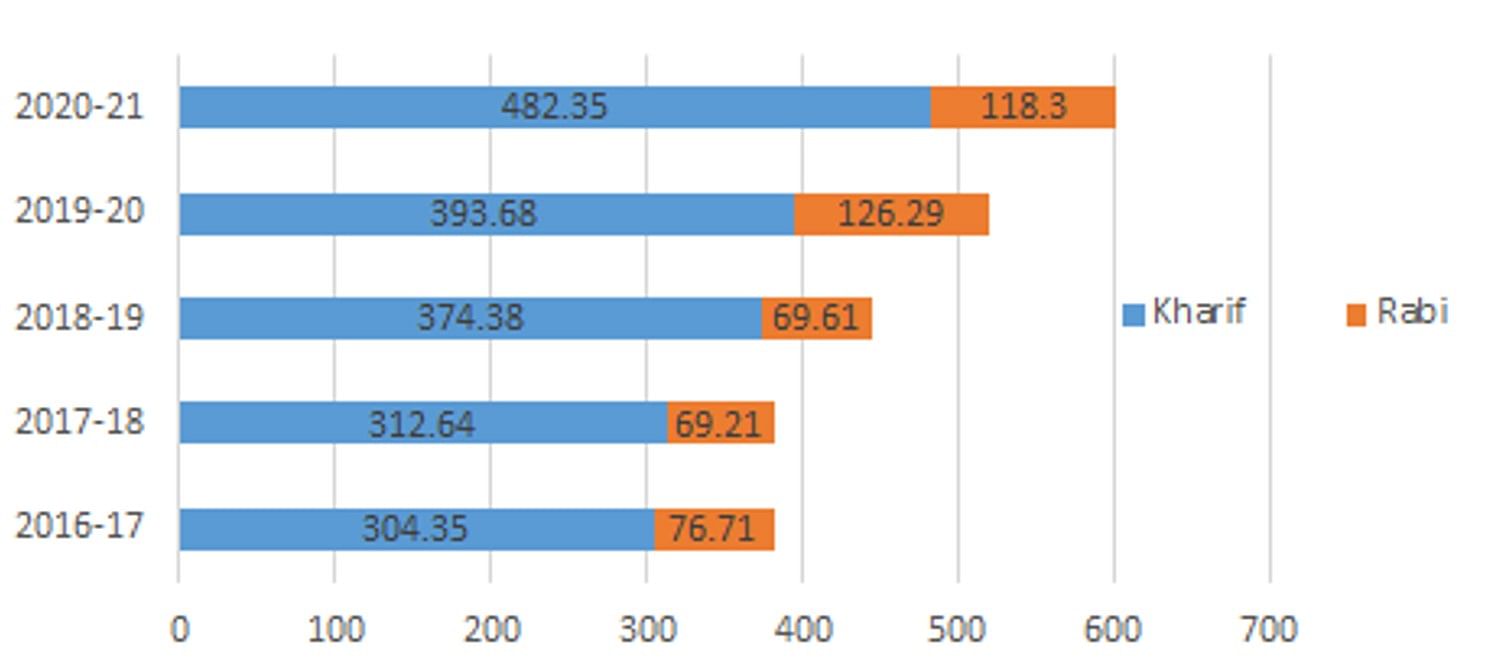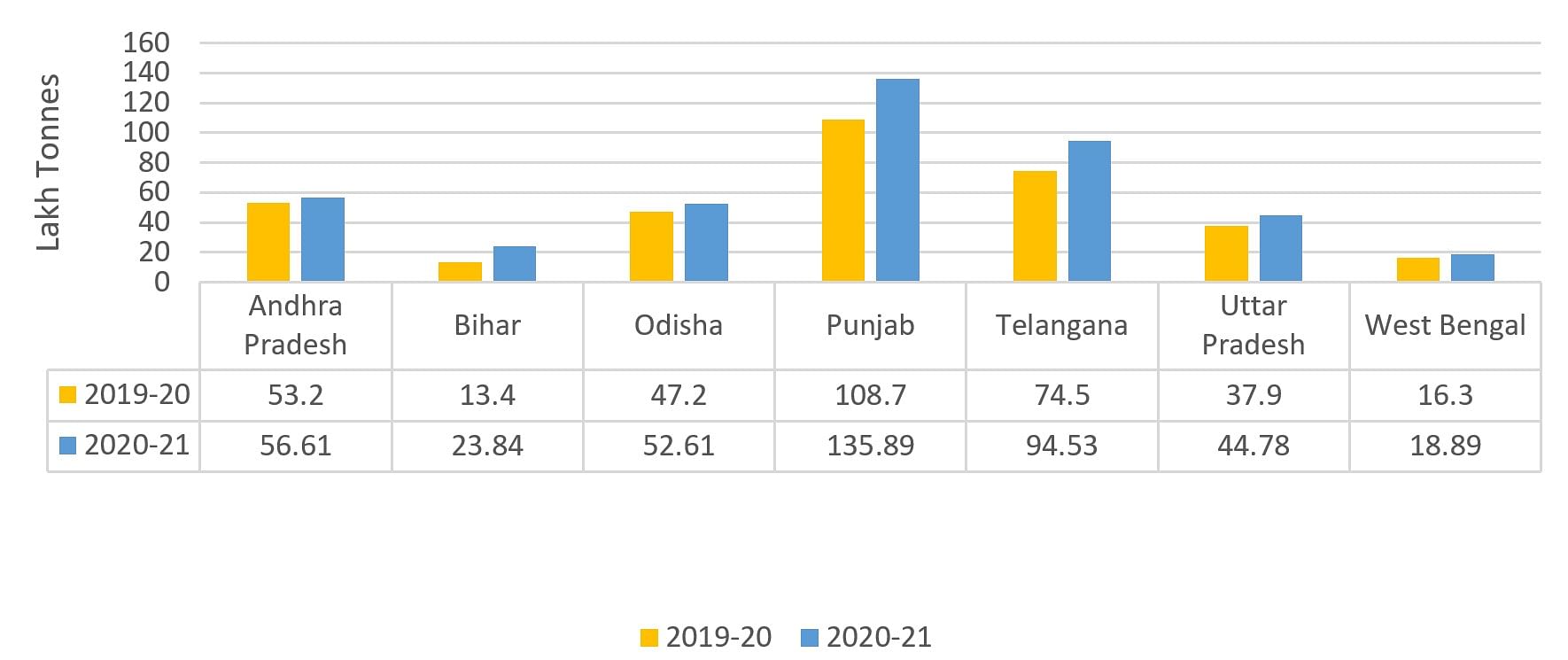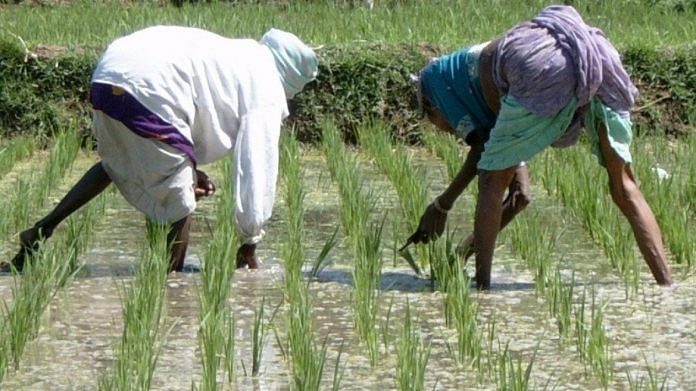The Kharif marketing season 2020-21 broke all previous records of rice procurement, with the government procuring 600.65 lakh tonnes of rice between October 2020 and September 2021. The new Kharif marketing season (KMS) began on 1 October.
As per the first advance estimate for 2021-22, the total production of rice in 2020-21 was 1,222.7 lakh tonnes. A working group of Niti Aayog (2018) estimated the total domestic demand in 2020-21 to be 1,100 lakh tonnes. India exported 177 lakh tonnes of rice during the year.
About half (49.12 percent) of rice produced in India was procured by the government agencies. Procurement of half of a country’s production of any crop shows that the free market is rather dysfunctional.
In October 2016, the Union government banned the levy on rice mills. Since then, government agencies procure paddy from farmers and it is handed over to rice mills, which deliver about 67 kg rice for every 100 kg of paddy. It is called Custom Milled Rice (CMR).
Due to the assurance of minimum support price (MSP) for paddy, farmers switch to the crop when irrigation facilities become available.
Though rice is produced in rabi season as well, it’s mainly produced in kharif season (broadly October to March). In 2020-21, according to the first advance estimate, the production in kharif was 1,044.1 lakh tonnes out of which 482.35 lakh tonnes (46.2 percent) was procured. The rice production in rabi (broadly April to September) was 178.6 lakh tonnes from which 118.30 lakh tonnes (66.2 percent) was procured by the government agencies. There is some overlap between kharif and rabi production and arrival in the market so the figures do not accurately represent the exclusive procurement out of production of kharif or rabi crops.
Figure 1: Rice procurement in kharif marketing season (lakh tonnes)

In the last five years, there is a visible trend towards much higher procurement of rice produced in rabi season (Figure 1). The states are using the flexibility provided by the Decentralised Procurement Scheme (DCP) to increase rice procurement. Rather than depend on traditional producers of rice (Punjab, Haryana, Andhra Pradesh), they use the rice so procured for distribution under the Public Distribution System (PDS).
In theory, the DCP system of procurement is more economical than the traditional system under which the rice procured by the state governments was handed over to the Food Corporation of India (FCI), which moved it to deficient states. An evaluation of the DCP scheme by Niti Aayog is pending for about five years.
Also read: Monetising FCI warehouses good. Modi govt must ensure revenue won’t go to fanciful projects
Non-traditional states ramp up rice procurement
In a welcome development, rice procurement in Bihar in KMS 2020-21 has gone up by about 78 percent over the previous year, though on a low base. Tamil Nadu also increased its procurement by about 60 percent and Punjab by about 25 percent (Figure 2).
The farmers’ protest against the three farm laws enacted by the Union government began on 25 November 2020 on the borders of Delhi, but the agitation in Punjab had started in June 2020 when the Ordinances were promulgated. There were several media reports of senior ministers taking credit for higher procurement from farmers. It was projected as a commitment of the government to the continuation of the MSP regime. Media reports pointed out that the increase in rice procurement was also due to traders bringing rice from adjoining states like Uttar Pradesh where the procurement in the initial period was not quite streamlined.
Telangana emerges as a large procurer of rice in rabi
If the entire KMS is taken into account, the real story of rice procurement in the last three years lies in higher procurement of rice in the rabi crop, which has witnessed an increase of about 70 percent – from 69.21 lakh tonnes in KMS 2018-19 to 118.3 lakh tonnes in 2020-21.
Telangana procured 61.8 lakh tonnes of rice in rabi season, highest in the country, followed by Andhra Pradesh (37.17 lakh tonnes), Tamil Nadu (12.10 lakh tonnes), and Odisha (9.81 lakh tonnes).
Figure 2: Major rice-producing states in which procurement has gone up

After Punjab, Telangana has become the second highest contributor of rice to the central pool. Taking both kharif and rabi in KMS 2020-21, Telangana procured 94.53 lakh tonnes of rice.
In June 2014, Telangana became a separate state. In KMS 2014-15, it had procured only about 35 lakh tonnes of rice. The increase in rice production resulting in high procurement is attributed to completion of several irrigation projects like Kaleshwaram and Devadula. Revival of tanks under Mission Kakatiya is also considered a success. In 2019-20, about 50 percent of net sown area was irrigated, up from 39 percent in 2014-15. Area under rice has increased from 1.42 million hectares in 2014-15 to 2.01 million hectares in 2019-20. Area under nutri-cereals has gone down in the same period.
Another reason for the higher area under cultivation is the decision of providing free electricity for agriculture from January 2018. This was in complete denial of Punjab’s experience of disastrous results of free electricity on underground water-table. The long-term effects of free electricity in Telangana may unravel in the near future.
Also read: Indian farmers defied Covid to sell record high rice and wheat. Time to expand PDS cover
Way forward
At the end of August 2021, the central pool stock was 786.2 lakh tonnes, about 86 lakh tonnes higher than last year. Despite additional allocation of 282.8 lakh tonnes of food grains under Pradhan Mantri Garib Kalyan Anna Yojana (PMGKAY), the central pool will continue to have huge surplus as compared to the buffer norms.
In the case of Punjab, influential voices have been writing for decades about the need to wean farmers from rice by offering them incentives. They have been pointing out that on agro-climatic considerations, Punjab is not suitable for cultivation of rice, especially common (non-basmati) varieties. Telangana is yet to attract similar arguments from scholars. As per the Ground Water Year Book 2020-21, out of 584 mandals in Telangana, 70 mandals are over-exploited, 67 mandals are critical, 169 mandals are semi-critical and only 278 mandals were under safe category.
Before the announcement of polling dates by the Election Commission for Uttar Pradesh, Uttarakhand and Punjab (elections are due in February-March 2022), some resolution of the farmers’ agitation can be expected. It could be in the form of keeping the three laws in abeyance till the 2024 Lok Sabha election. But, the situation of excessive production and procurement of rice in water-stressed regions is not likely to change in near term. As long as the incentive to grow rice is much higher than other crops, farmers will continue to produce rice.
Weaning farmers of water-stressed regions from rice requires not only more money as incentive but also a coordinated policy and incentive regime in which both the Union and the state governments are on the same page. In the current political scenario, it looks like a tall order.
The author, a retired Union Agriculture Secretary, is Visiting Senior Fellow at Indian Council for International Economic Relations (ICRIER). He tweets @sirajnoida. Views are personal.
(Edited by Prashant)



